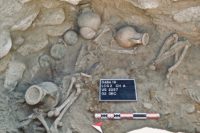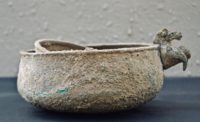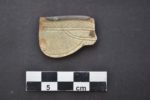 Archaeologists excavating an archaeological site in the Oman province of Dibba Al-Baya on the east coast of the Arabian Peninsula have unearthed an Iron Age tomb containing an Egyptian Eye of Horus amulet, the first ever discovered in Oman. The grave dates to between 100 B.C., the Late Iron Age, and 300 A.D., the Pre-Islamic Period.
Archaeologists excavating an archaeological site in the Oman province of Dibba Al-Baya on the east coast of the Arabian Peninsula have unearthed an Iron Age tomb containing an Egyptian Eye of Horus amulet, the first ever discovered in Oman. The grave dates to between 100 B.C., the Late Iron Age, and 300 A.D., the Pre-Islamic Period.
The Dibba archaeological site was discovered by accident in 2012. After initial surveys by local archaeologists, the Oman Ministry of Heritage and Culture invited an Italian archaeological mission to excavate it beginning in April 2013. The team has unearthed a funerary complex consisting of two large collective tombs (LCG1 and LCG2), a Parthian grave and a number of ritual pits filled with artifacts including gold jewelry, decorated inlaid shell medallions, bronze, soapstone and ceramic vessels, daggers, arrowheads, all of high quality and in generally excellent condition. Chamber graves constructed out of stones, the collective tombs were in use from the Late Bronze Age (1600-1350 B.C.) through the Pre-Islamic Period.
 From 2013 through 2018, archaeologists unearthed the skeletal remains of at least 188 people, more than 3,500 artifacts and 5,000 beads from LCG1 alone. LCG2, which was discovered during the second season of excavations in 2014, has been equally rich in remains and artifacts with more than 3,000 objects of high value unearthed thus far. Archaeologists have also found restored, expanded and reorganized structures indicating that LCG2 was repeatedly altered over the centuries of use.
From 2013 through 2018, archaeologists unearthed the skeletal remains of at least 188 people, more than 3,500 artifacts and 5,000 beads from LCG1 alone. LCG2, which was discovered during the second season of excavations in 2014, has been equally rich in remains and artifacts with more than 3,000 objects of high value unearthed thus far. Archaeologists have also found restored, expanded and reorganized structures indicating that LCG2 was repeatedly altered over the centuries of use.
 The newly-discovered grave was unearthed in LCG2. It was oval in shape and contains the skeletal remains of 12 individuals. Buried with them was a large complement of grave goods: glazed and unglazed pottery, bronze pots, iron heads, imported silver and gold jewelry. The Eye of Horus amulet, a symbol representing projection and good health, was also imported.
The newly-discovered grave was unearthed in LCG2. It was oval in shape and contains the skeletal remains of 12 individuals. Buried with them was a large complement of grave goods: glazed and unglazed pottery, bronze pots, iron heads, imported silver and gold jewelry. The Eye of Horus amulet, a symbol representing projection and good health, was also imported.
Sultan bin Saif Al Bakri, Director General of Antiquities, said, “this necklace is the second to be found at this site, where we had previously
found an amulet of the civilisations that originated in Iraq in the form of a stone inscribed with the cuneiform name [Gula], the deity of healing in the Mesopotamian civilisation. This was also used for protection and from for the deceased.
Jolla is said to be the greatest physician and healer of diseases in the Babylonian civilisation dating back to the second half of the second millennium BC. Many discoveries from the site have since found their way to the National Museum of Oman.
Dr. Francesco Genchi, the head of the Italian delegation from the University of Rome emphasized that the findings are indicative of the historic role Dibba played – located on the eastern coast of the Oman Peninsula, where it was linked to ancient global and regional trade routes.
He added that the archaeological evidence found so far indicates that Dibba was considered a sacred area of major importance in the understanding of Iron Age tribal societies across the Arabian Peninsula – and that this site in particular was of great importance for funerary rites.